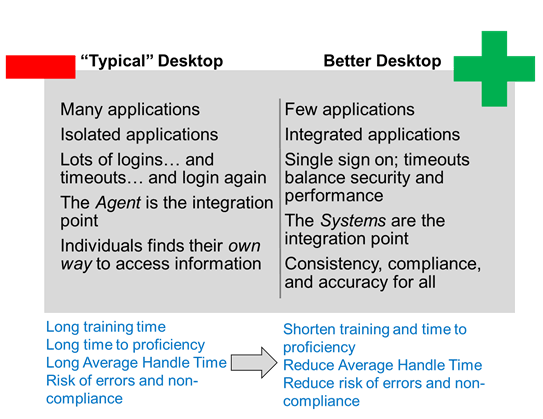It jumped out at me as big news: Lack of and/or bad desktop tools took the #1 spot on our challenges list for 2019. That data confirms what we see in countless projects.

Without good desktop tools, agents find their own way, and that may not be good! Some use copy and paste, while others are typing (or scribbling!) notes. One agent is jumping into Skype or Teams sessions, while another finds resources through the CRM chat tool. Others have set up a Slack channel while somebody else is trying out the chat in the new cloud solution! A variety of “cheat sheets” circulate – whether electronic or printed – and tribal knowledge is shared among those with proximity or affinity. All this personal navigating makes consistency and compliance nearly impossible.
The bad desktop tools and associated behaviors directly impact performance and contact center costs. It’s easy to look for symptoms such as long training times and time to proficiency, or long and inconsistent handle times. As agents click away on deep paths or bounce around to various applications, the clock is ticking. Every login (and timeout, and login again) has a price tag in precious seconds, not to mention frustration and mind-numbing tediousness that does not boost the very hot priority of employee engagement.
While the reliance on others – whom agents reach in various ways – can build valuable relationships across the center or the enterprise, the inconsistency in who is providing answers to whom, via what tools, means a lost opportunity for consistency and continuous improvement. At best, the bad desktop introduces more chances for errors. At worst, it fuels security and compliance risks.
So I am going to propose a tactic that is antithetical to many contact center leaders’ tendencies. You need to stop the heroics of making it work and show what it’s really like. You need to build awareness of the risks and impacts of a bad desktop, and show your business and IT leaders you have a problem!
I recognize that the desktop challenges linger in many organizations because these are not simple things to change. And I have yet to find anyone with ample time, resources, and budget for everything on their “to do” list much less their “wish” list. Heading down this path requires an assessment of the appetite for change and investment that goes with it.
A better desktop requires collaboration between IT and CC leadership. It may also require engagement of compliance/risk/security people. Bring them all together to drive a path to the better desktop. Don’t go searching for answers (and point solutions) in silos. Assess what you have and what your vendor partners have to offer. Get ideas from the center to identify pain points and opportunities, and ask, can we do this? Then seek input from IT.
The best results will come when you get creative about how to address the ideas, looking for quick hits, and then defining the longer-term IT plans. Some things that might provide immediate relief include:
- If agents have only one monitor, see if they can get a second. It can be one of the easiest ways to drive some efficiency and accuracy, and your agents will love you for it.
- Establish consistent processes on how to use notepads, written notes, IM tools – for security, efficiency/accuracy, responsiveness, and tracking.
- Give logins to the right people to ensure visibility to the right applications and information. The motto is “none of the ones I don’t need, all the ones I do need” to reduce clutter and facilitate timely first contact resolution.
- Single sign-on is sometimes a bigger effort but it’s become more commonplace and there are tools that can help. Don’t be afraid to push this one with IT.
- Review timeouts on various applications and set them to balance security and performance in the contact center.
It may seem daunting but tackling this issue can go a long way to making the desktop a better place for the agents to handle contacts, delivering benefits for the center, company, and customers. Then something else can move up to the top of the challenges list!
